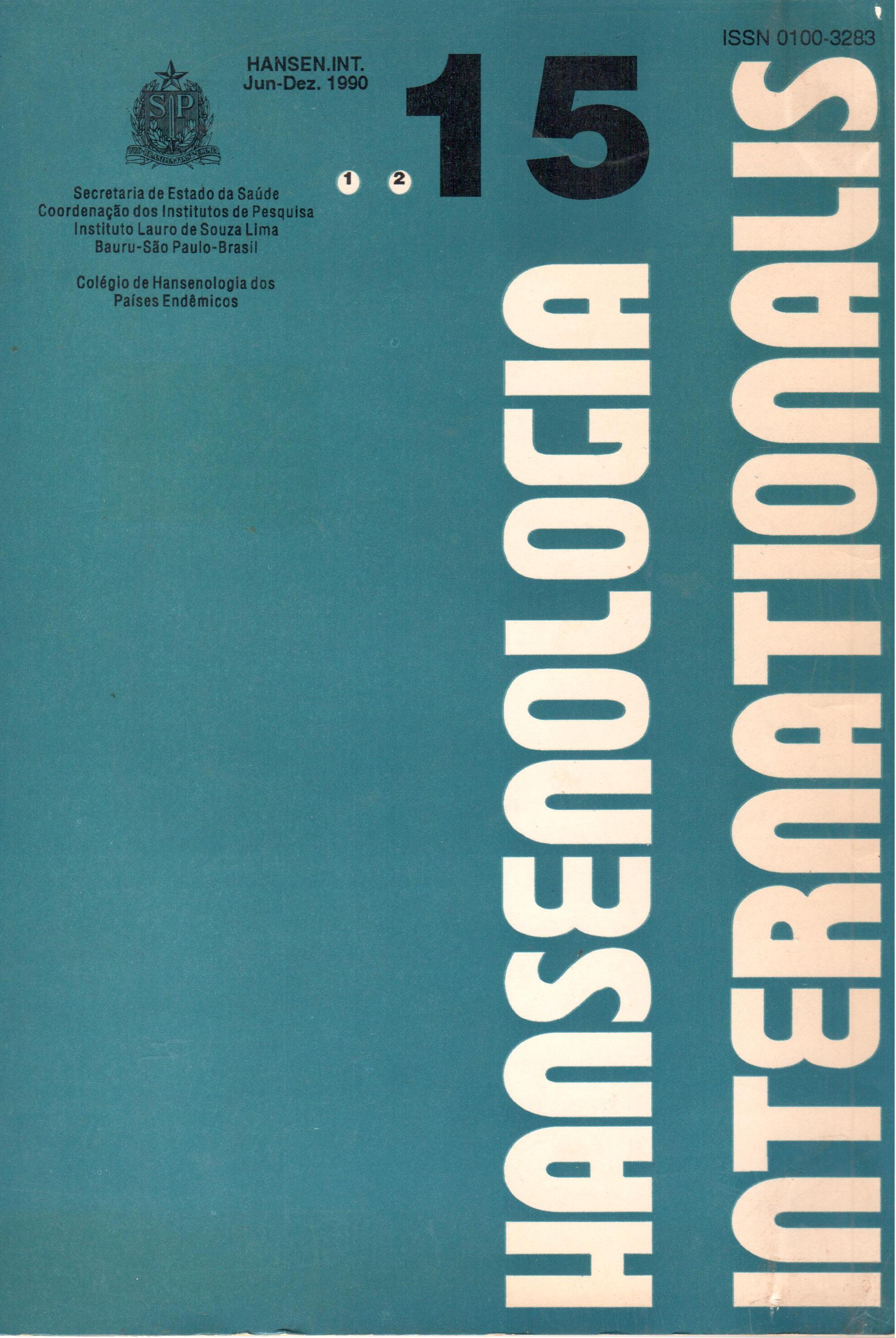Resumen
In three different groups of leprosy contacts there were observed results of intradermoreaction to the soluble antigen (SA). In urban area endemic for leprosy (prevalence rate of 2,87 per 1.000 inhabitants) there were studied three groups: 1) intradomiciliary contacts or living together with a case for more than one year; 2) neighboring contacts or extradomiciliary one's; 3) inhabitants in the areas far from the focus. Thirty nine per cent of the 1.569 intradermoreactions were positive. It was demonstrated an association between the positiveness of the intradermoreaction and the proximity of the infection source, with the age and the time of residence in the same dwelling. The SA was considered a good instrument for the identification of the groups of risk for leprosy, although the findings do not quantify its predicting value in the individual diagnosis of the infection.
Citas
2. AZULAY, R.D. Lepromino-reação em coletivi dade indene de lepra. Rev. Bras. Leprol., 30:97-102,1962
3. BECHELLI, L.M. A importancia das causas predisponentes na epidemiologia da lepra. Rev. Bras. Leprol.. 17:175-185,19494. BECHELLI, L.M. Simpósio sobre a epidemiologia e a profilaxia da lepra (1933/53). Rev. Bras. Leprol.,17:31-44, 1949.
5. BECHELLI, L.M.; KEIL, H.; ROTBERG, A. Resultados da leprominoreação em paises não endêmicos de lepra: nota preliminar. Rev. Bras. Leprol.. 13:21-24, 1945.
6. BECHELLI, L.M.; QUAGLIATO, R.; NASSIF, S.J. Lepromino-reação em holandeses radicados há 2-3 anos no Brasil e sem contato conhecido com doentes de lepra. Rev. Bras. Leprol.. 25:107-125, 1957.
7. BRASIL. Ministério da Saúde. Secretaria Nacional de Ações Básicas de Saúde. Divisão Nacional de Dermatologia Sanitária. Guia
para o controle da hanseníase. Brasilia, Centro de Documentação do Ministério da Saúde, 1984. 100p.
8. BRASIL. Ministério da Saúde. Secretaria Nacional de Ações Básicas de Saúde. Divisão Nacional de Dermatologia Sanitária. Normas técnicas e procedimentos para utiliza cão dos esquemas de poliquimioterapia no tratamento da hanseníase. Brasilia, Centro de Documentação do Ministério da Saúde, 1989. 73p.
9. CAMPO FILHO, N. & FRANCO, E.L. A microcomputer program for multiple logistic regression by unconditional and conditional
maximum likelihood methods. Amer.J.Epidemiol., 129:439-444, 1989.
10. CONVIT, J.; ARANZAZU, N.; ULRICH, M.; ZUNIGA, M.; ARAGÓN, M.E.; ALVARADO, J.; REYES, O. Investigation related to the developement of a leprosy vaccine. Int. J. Leprosy, 51:531-539, 1983.
11. CONVIT; J.; ARANZAZU, N.; ZUNIGA, M.; ULRICH, M.; PINARDI, M.E.; CASTELLAZZI, Z.; ALVARADO, J. Immunotherapy and immunoprophylaxis of leprosy. Lepr.Rev.(specialissue):47S-60S, 1983.
12. CONVIT, J.; PINARDI, M.E.; ARIAS ROJAS, F.; GONZALES, I.; COREY, G.; ARVELO, J.J.; MONZON, H. Tests with three antigens
in leprosy endemic and non-endemic areas. Bull. Wld. Hlth. Org., 52:193-198, 1975.
13. DHARMENDRA & CHATTERJEE, K.R. Prognostic value of the lepromin test in contacts of leprosy cases. Lepr. India, 27:149-152, 1955.
14. EPI INFO-VERSION'S. U.S. Department of health and Human Services. Public Health Service. Centers for Disease Control. Atlanta. Georgia. 1988.
15. FERNANDEZ, J.M.M. Importância das reações imunológicas no exame das crianças comunicantes de leprosos. Rev.Bras.Leprol., 12:201-211, 1944.
16.INE, P.E.M. Leprosy: the epidemiology of a slow bacterium. Epidemiol. Rev., 4:161-217, 1982.
17. FURTADO, T.A. &SCHULZ, K.H. Reatividade leprominica em indivíduos com tuberculo se cutânea provenientes de áreas não
endêmicas de lepra. Rev.Bras.Leprol., 33:75-79, 1965.
18. GODAL, T. & NEGASSI, K. Subclinical infection in leprosy. Brit.Med.J.. 3:557-559, 1973.
19. HABICH, J.P. Estandarizacion de metodos epidemiologicos cuantitativos sobre el ter reno. Bol.Ofic.Sanit.Panamer.. 76:375-384,
1974.
20. HARBOE, M. The immunology of leprosy. In: HASTINGS, R.C., ed. Leprosy. Edinburgh, Churchill Livingstone, 1985. p.53-87.
21. INFORME DA COMISSÃO DE IMUNOLOGIA IV Congresso Internacional de Lepra. Ma dri. 1953. Rev. Bras. Leprol.. 25:223/413, 1957.
22. LORD, R.; NAISH, C.; TAYLOR, C. Skin tests studies on close contacts of leprosy patients in India. Int.J.Leprosy. 57:801-809, 1989.
23.QUAGLIATO, R. &VEITIEKA, J. Revisão dos focos de lepra: cadastro lepromínico e exames de comunicantes pelo sistema de convocação-viabilidade, rendimento, as pactos econômicos. Rev.Bras.Leprol..26:273-293, 1958.
24. RAO, P.S.S.; KARAT, A.B.A.; KALIAPERUMA, V.G.; KARAT, S. Transmission of leprosy within households. Int.J.Leprosy. 43:4554, 1975.
25. ROTBERG, A. Fator "N" de resistência à lepra e relações com a reatividade lepromínica e tuberculínica: valor duvidoso do BCG na
imunização antileprosa. Rev.Bras.Leprol., 25:85-106, 1957.
26. SIMPÓSIO SOBRE FUNDAMENTOS PARA A UTILIZAÇÃO DO BCG NA PROFILAXIA DA LEPRA, Rio de Janeiro, 1957. Rev.Bras.Leprol.. 25:223-413, 1957.
27. SOUZA CAMPOS, N. Da importância da lepromino-reação no controle das crianças recolhidas nos preventórios. Rev.Bras.Leprol.. 14:3-20, 1946.
28. SOUZA CAMPOS, N. Condições que deter minam a positividade ao Mitsuda. Rev.Bras.Leprol.. 36:37-46, 1968.
29. STANFORD, J.L.; STANFORD, C.A.; SAID, K.G.; DONYLATI, Y.; YEISS, F.; FARSHCHI, Y., MADLENER, F.; JYRES, R. Vaccination and skin test studies on children of leprosy patients. Int. Bras. Leprosy. 57:38-44, 1989.
30. WORLD HEALTH ORGANIZATION. Epidemiology of leprosy in relation to control. Geneva, WHO, 1985. (WHO. Technical Report Series, n. 716)
31. WORLD HEALTH ORGANIZATION. Comité de Expertos. Geneva, WHO, 1988. (WHO. Thechnical Report Series, n.768)
32. ZUNIGA, M. Use of skin-test with M.leprae soluble antigen for epidemiological studies and vaccionation trials. In: INTERNATIONAL LEPROSY CONGRESS, 13., Netherlands, 1988. Transactions. Int.J.Leprosy, 57(supp1.1):334-335, 1989.
33. ZUNIGA, M.; CONVIT, J.; CASTELLAllI, Z. Vaccination dans la lepra: results preliminaires d'un assai an Venezuela. In: CONGRES INTERNACIONAL DE LA LEPRE, 12., New Delhi, 1984.
Esta revista tiene la licencia Creative Commons Attribution 4.0 International License.
